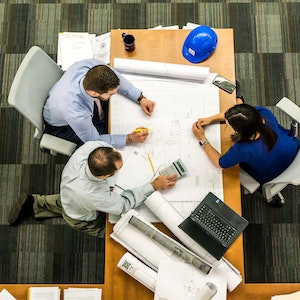Quantity Takeoff Methodologies
Posted by P.J. on Nov 28th 2022
Quantity takeoff is a crucial step in the construction process that involves measuring and calculating the quantities of materials and labor required for a project. It helps contractors, estimators, and project managers to determine the cost of a project and ensure that it is completed on time and within budget.

There are several methods for performing a quantity takeoff, and the most appropriate method will depend on the specific project and the type of materials involved. Here are some common methods for performing a quantity takeoff:

- Manual takeoff: This method involves manually measuring and calculating the quantities of materials needed for a project using blueprints, plans, and specifications. It is a time-consuming process that requires a lot of attention to detail, but it is useful for small projects or when there are no other options available.
- Digital takeoff: Digital takeoff involves using specialized software to measure and calculate the quantities of materials needed for a project. This method is faster and more accurate than manual takeoff, and it is particularly useful for large projects with many different types of materials.
- Augmented reality (AR) takeoff: AR takeoff involves using a smartphone or tablet to overlay digital information onto the physical environment. This allows estimators to measure and calculate quantities of materials in real-time, making it a fast and efficient method for performing a quantity takeoff.

Regardless of the method used, there are several key considerations that must be taken into account when performing a quantity takeoff:
- Accurate measurements: It is important to take accurate measurements when performing a quantity takeoff, as this will ensure that the quantities of materials and labor needed for the project are correctly calculated. This includes measuring the dimensions of the project site, as well as the quantities of each type of material needed.
- Detailed plans: Detailed plans and specifications are essential for performing a quantity takeoff, as they provide the necessary information about the materials, labor, and equipment required for the project. These plans should include drawings, schematics, and other relevant details about the project.
- Allowances: Allowances should be included in the quantity takeoff to account for materials and labor that may not be specifically called out in the plans and specifications. These may include things like waste, overlap, and other factors that can affect the quantity of materials needed for the project.
- Pricing: It is important to have current pricing information for the materials and labor needed for the project, as this will help to accurately determine the cost of the project. This can be obtained from suppliers, manufacturers, and other industry sources.

Once the quantities of materials and labor have been calculated, they can be used to create a bid for the project, which includes a breakdown of the costs for each phase of the project. This bid can then be used to negotiate the terms of the project with the client and secure the necessary funding.

In summary, quantity takeoff is a crucial step in the construction process that involves measuring and calculating the quantities of materials and labor needed for a project. It helps contractors, estimators, and project managers to determine the cost of a project and ensure that it is completed on time and within budget. There are several methods for performing a quantity takeoff, including manual takeoff, digital takeoff, and augmented reality takeoff, and it is important to consider accurate measurements, detailed plans, allowances, and pricing when performing a quantity takeoff.
Moreover, Pinch Estimating does professional quantity takeoff and estimates in a pinch! They have new packages being added on a daily basis. If you do not find one you like book a call and we can work together to tailor one to your specific needs.

